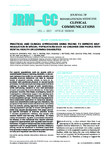Practical and clinical approaches using pacing to improve self-regulation in special populations such as children and people with mental health or learning disabilities
| dc.contributor.author | Edwards, A | |
| dc.contributor.author | Abonie, U | |
| dc.contributor.author | Hettinga, F | |
| dc.contributor.author | Pyne, D | |
| dc.contributor.author | Oh, Tomasina M | |
| dc.contributor.author | Polman, R | |
| dc.date.accessioned | 2022-03-08T12:57:38Z | |
| dc.date.issued | 2021-05-04 | |
| dc.identifier.issn | 2003-0711 | |
| dc.identifier.issn | 2003-0711 | |
| dc.identifier.other | 1000058 | |
| dc.identifier.uri | http://hdl.handle.net/10026.1/18920 | |
| dc.description.abstract |
For special populations such as people with a mental health issue or learning disability, a disconnect between the ability to accurately monitor and regulate exercise behaviour can lead to reduced levels of physical activity, which, in turn, is associated with additional physical or mental health problems. Activity pacing is a strategy used in clinical settings to address issues of pain amelioration, while self-pacing research is now well addressed in sport and exercise science literature. It has been proposed recently that these overlapping areas of investigation collectively support the development of self-regulatory, lifestyle exercise skills across broad population groups. Activity pacing appears to have substantial application in numerous development and rehabilitation settings and, therefore, the purpose of this short communication is to articulate how an activity pacing approach could be utilized among population groups in whom self-regulatory skills may require development. This paper provides specific examples of exercise practice across 2 discrete populations: children, and people with mental health and learning difficulties. In these cases, homeostatic regulatory processes may either be altered, or the individual may require extrinsic support to appropriately self-regulate exercise performance. A support-based exercise environment or approach such as programmatic activity (lifestyle) pacing would be beneficial to facilitate supervised and education-based self-regulation until such time as fully self-regulated exercise is feasible. | |
| dc.format.extent | jrmcc00057-jrmcc00057 | |
| dc.format.medium | Electronic-eCollection | |
| dc.language | en | |
| dc.language.iso | en | |
| dc.publisher | Medical Journals Sweden AB | |
| dc.subject | behaviour | |
| dc.subject | lifestyle intervention | |
| dc.subject | pacing | |
| dc.subject | physical activity | |
| dc.title | Practical and clinical approaches using pacing to improve self-regulation in special populations such as children and people with mental health or learning disabilities | |
| dc.type | journal-article | |
| dc.type | Journal Article | |
| plymouth.author-url | https://www.ncbi.nlm.nih.gov/pubmed/33968335 | |
| plymouth.issue | 1 | |
| plymouth.volume | 4 | |
| plymouth.publication-status | Published online | |
| plymouth.journal | Journal of Rehabilitation Medicine – Clinical Communications | |
| dc.identifier.doi | 10.2340/20030711-1000058 | |
| plymouth.organisational-group | /Plymouth | |
| plymouth.organisational-group | /Plymouth/Faculty of Health | |
| plymouth.organisational-group | /Plymouth/Faculty of Health/Peninsula Medical School | |
| plymouth.organisational-group | /Plymouth/REF 2021 Researchers by UoA | |
| plymouth.organisational-group | /Plymouth/REF 2021 Researchers by UoA/UoA03 Allied Health Professions, Dentistry, Nursing and Pharmacy | |
| plymouth.organisational-group | /Plymouth/Research Groups | |
| plymouth.organisational-group | /Plymouth/Research Groups/FoH - Community and Primary Care | |
| plymouth.organisational-group | /Plymouth/Research Groups/Plymouth Institute of Health and Care Research (PIHR) | |
| plymouth.organisational-group | /Plymouth/Users by role | |
| plymouth.organisational-group | /Plymouth/Users by role/Academics | |
| dc.publisher.place | Sweden | |
| dcterms.dateAccepted | 2021-03-30 | |
| dc.rights.embargodate | 2022-3-9 | |
| dc.identifier.eissn | 2003-0711 | |
| dc.rights.embargoperiod | Not known | |
| rioxxterms.versionofrecord | 10.2340/20030711-1000058 | |
| rioxxterms.licenseref.uri | http://www.rioxx.net/licenses/all-rights-reserved | |
| rioxxterms.licenseref.startdate | 2021-05-04 | |
| rioxxterms.type | Journal Article/Review |


